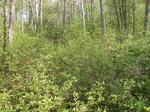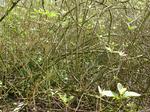| Home | About BFIS | Species List | Risk Analysis | Harmonia⁺ | Resources | Outputs | Mailing List | Registry |
| Contact us | Login | | ||||||
 |

©
Etienne Branquart

©
Etienne Branquart

©
Etienne Branquart

©
Etienne Branquart

©
Etienne Branquart

©
Etienne Branquart

©
Etienne Branquart

©
Etienne Branquart
 Naturalization in Belgium Naturalization in Belgium
 Invasiveness Invasiveness
More on invasiveness: Cornus sericea is mostly found on moist to humid eutrophic soils, where it can live with the roots submerged in water for most of the growing season. It thrives in early successional stages of riparian swamps and woodlands, but also in the understorey of open forests, along forest margins, in meadows and ruderal habitats. The plant is able to tolerate extremely cold temperatures. It is autosterile and pollinated by insects. Seeds, that are primarily dispersed by birds, have a double dormancy that needs both cold stratification and passage through bird gut to germinate. As it is commonly used as an ornamental and planted in gardens and public green areas, human also contribute to the dispersion of this shrub. It is increasingly observed in the wild, most of the time obviously as an escape from cultivation.
 Distribution in Belgium Distribution in Belgium
Established populations

Endangered areas

 Impacts on Species Impacts on Species
 Impacts on Ecosystems Impacts on Ecosystems
More on impacts: In open conditions, Cornus sericea has a very high growth rate and produces abundant flowering. It can quickly cover high surfaces and make a dense canopy, which reduces the development of native vegetation, strongly decreases plant species richness, reduces tree seedling establishment and inhibits succession development. Density can exceed 100 000 stems per hectare. Under a closed canopy, the plant doesn't produce flower but emits long and horizontal axes that root and give rise to many stocks. This allow it to achieve great lateral exploration and to migrate to a more favourable area or to wait until opening occurs. It is considered as a weed in the floodplains and in forest openings of its area of origin.
References:
CPS-SKEW (2006)
Cornus sericea.
From online fact sheets of the Swiss Commission for Wild Plants Conservation.
Charles-Dominique, T., Edelin, C. & Bouchard, A. (2009)
Architectural strategies of Cornus sericea, a native but invasive shrub of Southern Quebec, Canada, under an open or a closed canopy.
Annals of Botany 105(2): 205-220.
Converse, C. & Eckardt, N. (1987)
The Nature Conservancy, Virginia.
Crane, M. F. (1989)
In: Fire Effects Information System, [Online].
U.S. Department of Agriculture, Forest Service,
Rocky Mountain Research Station, Fire Sciences Laboratory (Producer).
Keil, P. & Loos G.H. (2005)
Preliminary account of ergasiophygophytic and xenophytic trees, shrubs and subshrubs in the Central Ruhrgebiet (Germany).
 Electronic Publications of the Biological Station of Western Ruhrgebiet 3: 1-12.
Lambinon, J., Delvosalle, L. & Duvigneaud, J. (2004)
Nouvelle fore de la Belgique, du Grand-Duché de Luxembourg, du Nord de la France et des régions voisines.
Editions du Patrimoine du Jardin botanique national de Belgique, Meise.
Meilleur, A. , Veronneau, H. & Bouchard, A. (1994)
Environmental Management 18: 907-921.
Meilleur, A., Veronneau, H. & Bouchard, A. (1997)
Environmental Management 21(3): 433–442.
Middleton, B. (2002)
Restoration Ecology 10(4): 723–730.
Van Landuyt, W., Hoste, I., Vanhecke, L., Van den Bremt, P. Vercruysse, W. & De Beer, D. (2006)
Atlas van de Flora van Vlaanderen en het Brussels gewest.
Nationale Plantentuin en het Instituut voor Natuur- en Bosonderzoek i.s.m. Flo.Wer vzw.
Verloove, F. (2006)
Scripta Botanica Belgica 39, 89 pp.
Weber, E. & Gut, D. (2004)
Assessing the risk of potentially invasive plant
species in central Europe.
Journal for Nature Conservation12: 171-179.
|
 |
 |







